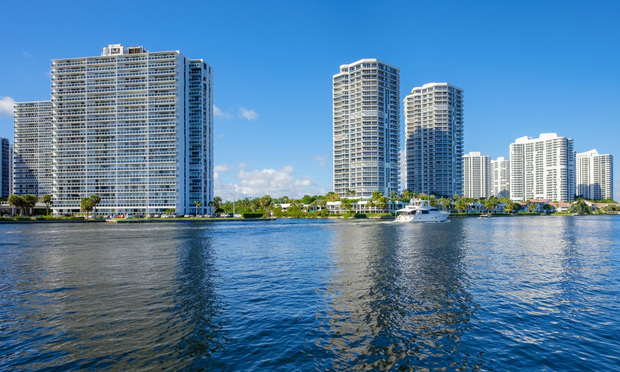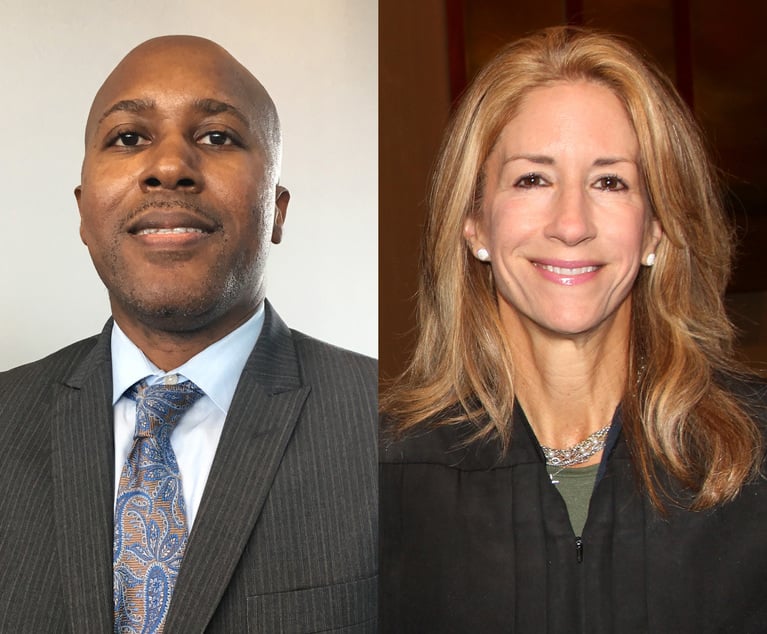Stream of Foreign Buyers Grows in South Florida But Slows in Miami-Dade
Foreign homebuyers in Miami-Dade represented about 51 percent of all buyers, less than in previous years, a study shows.
February 09, 2018 at 03:08 PM
4 minute read

South Florida housing is an even bigger draw for foreign buyers, whose spending bumped up by double digits in the latest annual report.
Foreign buyers spent $7.1 billion on 15,400 properties in the year ended July 2017 in Miami-Dade, Broward, Palm Beach and Martin counties, about 14.5 percent more than the previous year, according to a Miami Association of Realtors study.
But in Miami-Dade, fewer foreign buyers were seen, according to the association's 2017 Profile of International Home Buyers. They represented 51 percent of all buyers, down from 66 percent of all buyers the previous year and 69 percent the year before.
Foreign buyers represent less than half of the market in other South Florida counties.
“It's huge when you compare it to other areas in the U.S. and in Florida even to other counties,” said association senior vice president Lynda Fernandez. “Miami-Dade County will always be the most international market in the U.S. and will continue to attract international buyers, and they will continue to be a very important force in our market. ”
In Broward County, foreign buyers were 32 percent of all home purchasers, up from 27 percent the prior year. In Palm Beach County, they represented 9 percent of all homebuyers, up from 4 percent the prior year, according to the study.
Foreigners could have been looking beyond Miami-Dade to get more for their money, Fernandez said. Miami-Dade traditionally has been popular with Latin Americans, but a weak economic recovery in some Latin American countries also could account for the drop in Miami-Dade, she added.
Notably, the Canadian dollar remained stable against the U.S. dollar, and the share of Canadian buyers increased, while the U.S. dollar strengthened against the Venezuelan bolívar and the share of Venezuelan buyers in the region decreased, according to the study. Brazilians and Colombians also made less of a showing in the study.
“Canadians favor Broward over Miami-Dade, so if there were economic factors that were helping Canadians or incentivizing Canadians to purchase more property in South Florida, then that would definitely cause an increase in that sense,” Fernandez said.
It's no surprise then that Canadians were the best represented in Broward, accounting for 12 percent of all foreign buyers. Argentina followed at 8 percent, while Brazilians, Colombians and Venezuelans each held 6 percent of the market share, according to the study.
Canadians also seem to favor Palm Beach County where they were 31 percent of all foreign buyers, followed by Brazilians at 15 percent, according to the study.
Venezuelans, despite hyperinflation at home, still were the majority among all foreign homebuyers in Miami-Dade at 12 percent, the study found. Argentina and Brazil each held 9 percent of the market share in Miami-Dade, and Colombians represented 5 percent of all foreign buyers.
Other foreigners who bought homes in South Florida were people from the UK, China and Germany each representing 3 percent of international sales in the region, and Russians represented 2 percent, according to the study.
WHO BUYS?
Most foreign buyers paid cash and didn't buy with plans to move here permanently, preferring to invest or vacation, according to the study. About 66 percent of sales were all-cash deals, down from 72 percent the previous year.
About 38 percent of foreign buyers planned to rent their new purchases, and 15 percent said they were buying a vacation home, according to the study.
And that's characteristic across the region, Fernandez said.
“Foreign buyers who primarily reside abroad accounted for 69 percent of the foreign buyers compared with the 42 percent nationally, which I think is characteristic of our area. They are using it as an investment or to spend part of their vacation here, but they are not moving here necessarily,” she said.
Foreign buyers spent a median $339,300 compared with $302,300 spent by foreigners buying in the rest of the U.S. and $259,400 elsewhere in Florida, the study found.
The Miami Association of Realtors, a trade organization for brokers, Realtors and other real estate professionals, did the study with the National Association of Realtors by sending surveys to its 45,000 members in Miami-Dade, Broward, Palm Beach and Martin counties. A total of 636 responses were received.
The study has been done annually since 2011.
This content has been archived. It is available through our partners, LexisNexis® and Bloomberg Law.
To view this content, please continue to their sites.
Not a Lexis Subscriber?
Subscribe Now
Not a Bloomberg Law Subscriber?
Subscribe Now
NOT FOR REPRINT
© 2025 ALM Global, LLC, All Rights Reserved. Request academic re-use from www.copyright.com. All other uses, submit a request to [email protected]. For more information visit Asset & Logo Licensing.
You Might Like
View All
Yacht Broker Says It 'Has Done Nothing Wrong.' Asks Miami Court to Dismiss the Case

Hyper-Reality Revisited: A Tour of Waldorf Astoria Hotel & Residences Miami
5 minute read
10 Years Later, This High Court Fight Over Real Estate Commissions Is Far From Over
4 minute read
Broward Judge Awards $9.9M in Attorney Fees and Costs After $33M Salmon Settlement
4 minute readTrending Stories
- 1With AI, What Changes Can Midsize Firms Expect?
- 2Saul Ewing Loses Two Partners to Fox Rothschild, Marking Four Fla. Partner Exits in Last 13 Months
- 3Eagles or Chiefs? At These Law Firms, Super Bowl Sunday Gets Complicated
- 4Former NY City Hall Official Tied to Adams Corruption Probe to Plead Guilty
- 5Wilmer, White & Case, Crowell Among the Latest to Add DC Lateral Partners
Who Got The Work
J. Brugh Lower of Gibbons has entered an appearance for industrial equipment supplier Devco Corporation in a pending trademark infringement lawsuit. The suit, accusing the defendant of selling knock-off Graco products, was filed Dec. 18 in New Jersey District Court by Rivkin Radler on behalf of Graco Inc. and Graco Minnesota. The case, assigned to U.S. District Judge Zahid N. Quraishi, is 3:24-cv-11294, Graco Inc. et al v. Devco Corporation.
Who Got The Work
Rebecca Maller-Stein and Kent A. Yalowitz of Arnold & Porter Kaye Scholer have entered their appearances for Hanaco Venture Capital and its executives, Lior Prosor and David Frankel, in a pending securities lawsuit. The action, filed on Dec. 24 in New York Southern District Court by Zell, Aron & Co. on behalf of Goldeneye Advisors, accuses the defendants of negligently and fraudulently managing the plaintiff's $1 million investment. The case, assigned to U.S. District Judge Vernon S. Broderick, is 1:24-cv-09918, Goldeneye Advisors, LLC v. Hanaco Venture Capital, Ltd. et al.
Who Got The Work
Attorneys from A&O Shearman has stepped in as defense counsel for Toronto-Dominion Bank and other defendants in a pending securities class action. The suit, filed Dec. 11 in New York Southern District Court by Bleichmar Fonti & Auld, accuses the defendants of concealing the bank's 'pervasive' deficiencies in regards to its compliance with the Bank Secrecy Act and the quality of its anti-money laundering controls. The case, assigned to U.S. District Judge Arun Subramanian, is 1:24-cv-09445, Gonzalez v. The Toronto-Dominion Bank et al.
Who Got The Work
Crown Castle International, a Pennsylvania company providing shared communications infrastructure, has turned to Luke D. Wolf of Gordon Rees Scully Mansukhani to fend off a pending breach-of-contract lawsuit. The court action, filed Nov. 25 in Michigan Eastern District Court by Hooper Hathaway PC on behalf of The Town Residences LLC, accuses Crown Castle of failing to transfer approximately $30,000 in utility payments from T-Mobile in breach of a roof-top lease and assignment agreement. The case, assigned to U.S. District Judge Susan K. Declercq, is 2:24-cv-13131, The Town Residences LLC v. T-Mobile US, Inc. et al.
Who Got The Work
Wilfred P. Coronato and Daniel M. Schwartz of McCarter & English have stepped in as defense counsel to Electrolux Home Products Inc. in a pending product liability lawsuit. The court action, filed Nov. 26 in New York Eastern District Court by Poulos Lopiccolo PC and Nagel Rice LLP on behalf of David Stern, alleges that the defendant's refrigerators’ drawers and shelving repeatedly break and fall apart within months after purchase. The case, assigned to U.S. District Judge Joan M. Azrack, is 2:24-cv-08204, Stern v. Electrolux Home Products, Inc.
Featured Firms
Law Offices of Gary Martin Hays & Associates, P.C.
(470) 294-1674
Law Offices of Mark E. Salomone
(857) 444-6468
Smith & Hassler
(713) 739-1250






